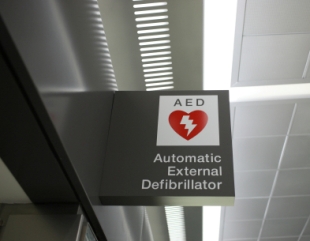Of the many variables that affect survivability for a person who experiences sudden cardiac arrest (SCA), one of the most important is how rapidly the AED is physically delivered to the victim's side. Indeed, few life threatening emergencies are as time sensitive as SCA.
Accessible, well-marked, near telephone
AEDs should be placed in easily accessible, well-marked locations, ideally near telephones:
- One minute away: Ideally,AEDs should be placed so that (a) the response time (time from collapse to arrival of responder with AED) is no more than 2 minutes and (b) the call-to-shock interval (time it takes to notify designated responders, the AED is accessed, reaches the victim's side, the electrodes are applied and the first shock delivered) is no more than 4 minutes. This means the AED should be no further than 1 minute away (one minute to get to the AED and one minute to return). Every sports field should have an AED in close range.
- Easily accessible: AEDs have no value if they are hidden, locked in an office, or otherwise placed where they are not easy to access and/or see.
- Near telephone: should be placed near phones so that 911, the first link in the cardiac chain of survival can be called while the AED is being retrieved. For outdoor athletics, a cell phone may fit the bill allowing responders to call while they are on their way to the AED. You might actually consider providing a cell phone with the AED, programmed to autodial 911 as soon as it is turned on.
Site assessment is critical
An assessment should be done to make sure that an AED is located within a 2-minute brisk walk of every nook and cranny of a school or to the farthest reaches of an athletic field. This is something you can do yourself; you don't need an AED manufacturer's rep. to do it for you.
In performing this assessment, you need to consider both the mode of transport and conditions that might impede transport:
- Rapid walking
- Running
- Snow skis/snowboard
- Snowmobile
- Golf cart
- Boat
- Elevator
- Escalator
- All-terrain vehicle
- Car/van/truck/tractor/motorcycle
You also need to consider conditions that might impede/slow down transport:
- Barriers
- Confined space
- Steep terrain
- Multiple floors
- Mass exodus/crowding
- Controlled access/locked doors
- Unpaved/uneven surfaces
- Blocked passageways
- Most direct route blocked
- Weather

- Construction
- Secure areas
- Limited response vehicles (resources being used for another response)
- Limited trained response personnel
- Traffic (times of day/year/special events)
- Distance
Colorful Signs & Stickers Needed
Once a location(s) is selected, make sure that everyone knows where the AED is. Here are some ways to do that:
- Place signs or symbols on AED cabinet, large enough to be seen at a distance
- Use colorful self-stick labels on glass doors of AED cabinet
- Post locations on bulletin boards (a heart logo with either "AED Location" or "Defibrillator Location") followed by the physical location of the device will direct people to it.
- Place directional signs near all fire extinguishers (even if there are more extinguishers than AEDs)








